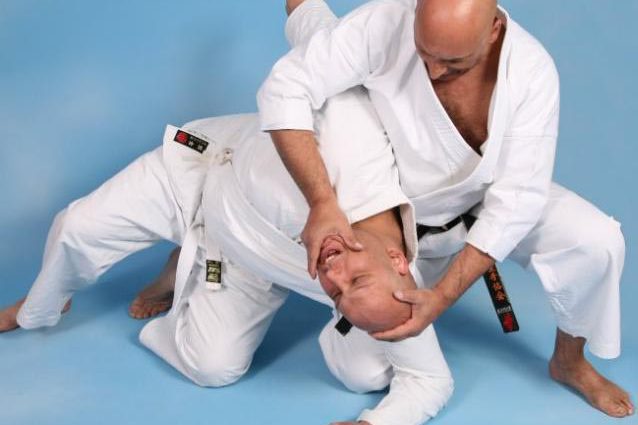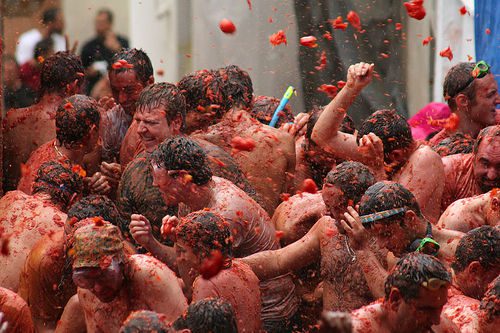The following article is composed from different quotes and teachings of the late Shuri-te Karate expert Chibana Choshin (1885-1969), founder of the Kobayashi-ryu (Kobayashi Shorin-ryu) style of Karate (one of the most widely practised in Okinawa today).
The article was put together by somebody unknown, and has simply been passed down to several senior practitioners of Shorin-ryu whom apparently often makes use of it in different publications. I threw in a little editing myself too.
This article benefits all Karate students, regardless of style.
May the spirit of the Shuri-warrior Chibana be with you!
Enjoy!
Butoku (Martial Virtue)
The great master Itosu Anko studied Karate very hard. He was not only a great Karate expert, but a scholar and excellent calligrapher. I first visited Anko Itosu in 1899 and asked him to teach me Uchinan-no-te [old name for Karate].
Twice he refused me, leaving me waiting at his entrance gate. Only upon asking him for the third time did he finally accept me as a personal student.
He taught Karate secretly at his home to a select group of about six or seven followers. They trained in Bu (Karate as a martial art), not as sport, as they do now. During that period of time I, too, kept my training a secret, even from my family. In 1903, or 1904, Itosu sensei began to publicly teach Karate in the school setting. It was at this time that I told my parents that instead of going to school I had been practicing the art of “te.”
In 1918 a group of Karate enthusiasts (Hanashiro Chomo, Kyan Chotoku, Miyagi Chojun, Mabuni Kenwa, Go Kenki, Oshiro Chojo, Yabu Kentsu, Kyoda Juhatsu, Yabiku Moden and myself) formed a group for Karate study since the two greatest teachers had died (Itosu Anko and Higaonna Kanryo both died in 1915). It was called the Karate (written as Tode) Kenkyukai which was established in Shuri City.
This was the first time that practitioners of different methods (Shuri, Naha and Tomari styles) met to train together and exchange information. Each time we met one senior would lead the training and all would benefit from their knowledge. This lasted until 1929 when, because of the popularity of this art, we all became too busy with our own students to train collectively.
I first began to teach Shuri-te Karate-jutsu in 1920 but by 1929, at the age of 44, I opened my first training hall (dojo) in Shuri City. In 1933 my good friend and colleague, Magusuku (Miyagi) Chojun, and I registered the names of our respective teachings with the Dai Nippon Butokukai (Greater Japan Martial Virtue Association). I called my teachings Shorin-ryu meaning the “small forest style.” My colleague, Chojun-sensei, called his style the Goju-ryu meaning “the half hard and half soft style.”
We were good friends and he died in 1953. He was a good colleague and a friend to all Shorin practitioners. He is missed.
Both Bucho (Bushi) Matsumura and Itosu Anko were poor. When I spoke of this to Itosu he told me that this was not a universal truth, that is that a martial person is poor. He stated that Okinawan bushi (warriors) were poor because they did not know how to handle money, as was the custom back then.
A true Okinawan martial artist makes his living away from the martial arts. They should not concern themselves with the making of money out of teaching the martial arts. A martial person must make their living away from the martial arts so as not to contaminate it through the influence of “making money” in order to “make a living.”
This is the Okinawan way.
Karate, as it is transmitted, changes every few years. This is a common phenomenon. It happens because a teacher must continue to learn and adds his personality to the teachings. There is an old Okinawan martial arts saying that states that Karate is much like a pond. In order for the pond to live, it must have infusions. It must have streams that feed the pond and replenish it. If this is not done then the pond becomes stagnant and dies. If the martial arts teacher does not receive infusion of new ideas and/or methods, then he, too, dies. He stagnates and, through boredom, dies of unnatural causes.
I remember learning the kata Tawada Patsai (Passai/Bassai) from Tawada-sensei. At that time I was receiving instruction from Itosu and he, too, taught a version of Patsai kata which he called the Matsumura Patsai, which I learned.
In 1913 or 1914, having practiced the Tawada-no-Patsai with all my heart, as was the custom back then, I approached Itosu and advised him of this. He asked me to demonstrate the kata for him. I did and Itosu then stated to me that was the finest performance of this rarely seen form that he had ever witnessed.
He then told me that this form must be preserved and passed on to future generations and to add it to his (my) teachings. So [in Kobayashi-ryu] the Matsumura Patsai is now called the Patsai-no-sho and the Tawada Patsai is called Patsai-no-dai.
Many of today’s practitioners are too timid in their training. They train with only the thought of being able to finish and not with the thought of progressing – pushing yourself to become better. You must train hard if you want to progress otherwise you are just a mediocre practitioner, and there are many of them.
If you wish to learn mediocre karate, go some place else and do not waste my time.
If a teacher teaches with his heart he can only expect the student to train with their heart. It is only right – then both the teacher and the student progress. The student motivates the teacher and the teacher teaches the student the correct attitude and spirit of the Okinawan martial arts. This is good training – the student and the teacher progressing together!
When you train you have to devote yourself only to the way of Karate – think of nothing else. Do not think of others, or what they may think. You must develop the ability to focus your mind, hands and feet strongly. You must not only learn body movements but also research and study the art itself [Bun Bu Ryo Do].
You should develop and improve yourself before you reach the age of fifty. Your body naturally begins to deteriorate after fifty years old so you must then adjust your training accordingly. If after fifty you still train every day then you may not decline so much. I noticed a slight decline at age fifty, but I don’t think I declined much at all between fifty and sixty years of age.
Of course, you cannot help deteriorating to a degree but if you continue training you will not age so rapidly, even between seventy and eighty years of age. Therefore, train continuously.
In the old days we trained at Karate as a martial art, but now they train at Karate as a gymnastic sport [remember, this was written a long time ago in Okinawa!] I think we must avoid treating Karate as a sport – it must be a martial art at all times!
Your fingers and the tips of your toes must be like arrows, your arms must be like iron. You have to think that if you kick, you try to kick the enemy dead. If you punch, you must thrust to kill. If you strike, then you strike to kill the enemy [Ikken Hissatsu].
This is the spirit you need in order to progress in your training. The effort required is great, and you can strain the body by doing too much. So keep in mind your own physical condition and train accordingly.
Years ago I decided that through my own hard training I wanted to leave my name connected with Okinawan Karate-do. I trained hard and taught to the best of my ability and talent. Now I think that my name will remain a little in the history of Okinawan Karate-do.
Not only do we need physical training, we need to think for ourselves, studying and researching the kata and their applications.
It is vitally important to understand kata and train your body to develop the core of Karate. You can achieve a five or six times increase in your body power if you train hard. Naturally, if you do this you will be pleased with the result, so train very hard.
Whether you become great depends on only two factors – effort and study. Your movements must be sharp – never be slow – and when you train at kata your eyes will get sharper and your blocking and striking will get stronger. Even when you reach the age of seventy or eighty you must continue your research with a positive attitude, always thinking “not yet, not yet…”
Chibana Choshin passed away in 1969, from throat cancer, at the age of 83.
He never stopped training.



11 Comments